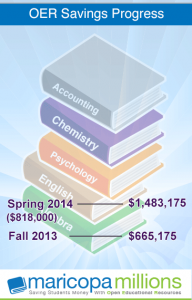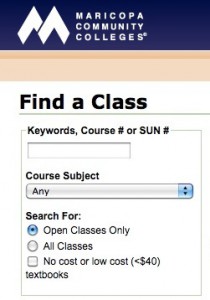Saving Students $5 Million over 5 Years
What is the goal of the project?
The Maricopa County Community College District (MCCCD) has refined several existing definitions of open educational resources (OER) and defined it for their purposes as teaching, learning, and research resources that are copyright-free or have been released under a creative commons license that permits others to reuse, revise, remix and redistribute them. Examples of OER include: full courses, course modules, syllabi, lectures, homework assignments, quizzes, lab and classroom activities, pedagogical materials, games, simulations, and many more resources contained in digital media collections from around the world.
The goal of the Maricopa Millions project is to radically decrease student costs by offering LOW COST or NO COST options for course materials. Courses designated as NO COST will have no additional cost to the student beyond fees associated with tuition. These might include OER, licensed online resources purchased by the MCCCD for student access, etc. Courses designated as LOW COST will have required course materials that are under $40. These costs may be associated with copyrights for textbooks, printing of required materials, online homework/quizzing systems, etc.
What is being done to meet the goal?
Strategic Approach
During spring 2013, a group of MCCCD faculty were asked to evaluate the use of OER and develop a recommendation for the direction of the district in regard to OER. The result was a proposal to develop a steering team to lead and coordinate a district-wide collaboration for the implementation and adoption of OER.
The OER Steering Team with support from Executive Vice Chancellor and Provost Dr. Maria Harper-Marinick, the project’s executive sponsor, is comprised of college presidents, deans, faculty, IT personnel, library faculty and instructional designers. It is led by tri-chairs comprised of academic faculty, instructional design faculty, and a Dean of IT who also teaches using OER. Convened in fall 2013, the team immediately drew up and implemented a strategic plan which was based on building awareness of OER, establishing standards and guidelines for use of OER, encouraging adoption of OER in high enrollment classes, evaluating the impact of OER, and establishing connections with others who are implementing OER projects.
Increased Awareness
Through the work of the OER Steering Team and in cooperation with the MCCCD Information Technology Services group, a search field has been created in the student information system so students can conduct online searches for their classes with No Cost and Low Cost options.
OER Adoption Internal Grants
The Maricopa Millions project will be calling for proposals for the third phase of internal grants during the Fall 2014 semester. The grants focus on aligning and or developing OER materials with the course curriculum and course competencies for the District’s high enrollment and developmental courses. To date, First-year Composition I & II, Developmental Reading, General Chemistry, and Student Success Strategies are the courses that have been funded. The English course materials are currently being piloted. The grants include training on OER, development/alignment of OER materials, and piloting the materials over a 1-1.5 year period.
OER Review Process
We are currently reviewing and evaluating rubrics for evaluation and review of OER materials. We hope to have a final version to share in early 2015,
Networking
It is important to MCCCD to learn from others as well as to help others in their OER initiatives. To this end, partnerships from formal partnerships to informal relationships have been forged with CCCOER, OEC, OER Research Hub, Mohave Community College, Tacoma Community College, OpenStax, Lumen Learning, and more.
What is the impact on students?
During the 2013-2014 academic year, MCCCD students saved over $1.6 million in course material costs by using no cost or low cost materials.
What issues have been encountered?
Of course, with any initiative there are issues that have been encountered. It was somewhat difficult to establish baseline data in regard to what classes were using OER, no cost, and low cost materials. Furthermore, it was difficult to define what “low cost” is. We turned to our students to come up with the $40 value. The addition of our Student Information System search filter will surely help with that. Additionally, we struggled with how to quantify cost savings. After much research, the OER Steering Team settled on $100 per textbook for a 20 student class to determine cost savings.
What is next?
As our grants move out of the pilot phase, we will be working with the faculty who obtained grants for their OER classes to promote their materials and increase adoption of those materials.

